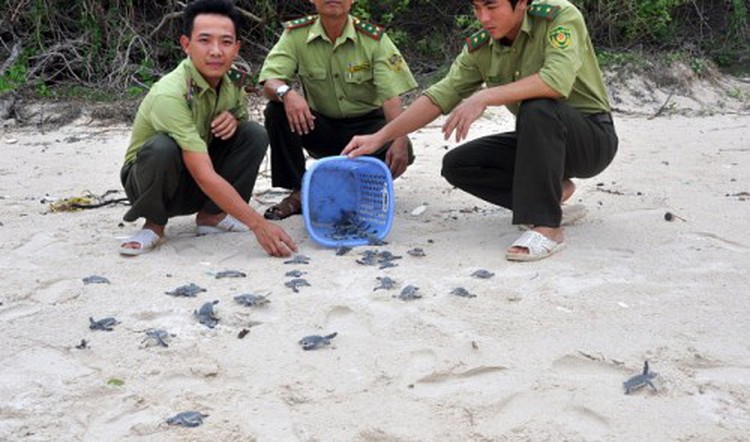
Millions of sea turtles have been born on the beaches of Con Dao Islands, 185km south of the southern Vietnamese city of Vung Tau, over the past 25 years, and their ‘midwives’ are the local forest management staff.
Taking care of sea turtles consumes most of the time of the rangers on the mountainous archipelago of Con Dao, including 16 islands covering a total area of 76 square kilometers.
At night, they take turns to watch for mother turtles to lay eggs in the darkness on sandy beaches, tag the mother reptiles, and pick the eggs to take home and hatch in an incubator.
Youngsters will be released back into the natural environment after some 45-60 days in incubator.
With such protection, a large number of the marine reptiles with bony shells and flippers, come ashore annually on Con Dao’s sandy beaches to lay eggs, mainly from April to November.
Islets in Con Dao such as Bay Canh, Tre Lon, Cau and Tai are regularly frequented by turtles, with Bay Canh accounting for 90 percent of mother turtles coming to lay eggs.
A night with mother turtles
Nguyen Van Anh, chief of a forest management unit in Con Dao, revealed, “Those turtles who crawl perpendicularly from the sea onto beaches are there to lay eggs. Those who crawl a parallel line along the water’s edge are just probing the sites they will return to lay eggs at a few days later.”
Anh pointed at a turtle crawling straight toward a shrub on the beach one night. It began digging a 50-60cm deep and 20cm wide hole with its rear legs to lay eggs.
Turtle eggs look like and are about the size of a table tennis ball.
After laying over one hundred eggs in the hole, the turtle filled it with sand for camouflage.
“Sea turtles are sensitive to light and sound when crawling on a sandy beach.
“If surprised, it will immediately stop laying eggs and return to the water,” Anh said.
After noting information about the mother turtle and the date of laying eggs, Con Dao rangers will take the eggs home to hatch them in an incubator.
On this night, the turtle laid 155 eggs.
Turtle eggs must be taken from the beach to the incubator within six hours after they are laid, otherwise they will be broken with minimum force.
Half of the eggs are put in an incubator with more light and a higher temperature to hatch males, while the others receive less light and a lower temperature to hatch females, according to Nguyen Van Tra, vice head of the Con Dao forest management force.
That night, 18 mother turtles crawled on sandy beaches, and nine of them laid eggs, while the others probed the sites.
Any mother turtle laying eggs in Con Dao is noted with a tag on its shell.
Each ranger on duty is equipped with a backpack, a flashlight and a basket to carry eggs. They have to patrol beaches all night to take home eggs for hatching.
Sea turtles are also sensitive to the place they give birth, and they will return to the exact spot where they were released to the sea to lay eggs.
That is why rangers do not release youngsters into water, but on sandy beaches to let them crawl down to the water to memorize the site they will get back to later.
Each mother turtle lays eight to eleven nests each season, and each nest has 70-200 eggs.
Regardless of this great number, the survival rate of young turtles in a natural environment is just 0.1 percent, or every one out of a thousand.
Fights against thieves
Turtle eggs are always targeted by thieves because of their expensive price, even though rangers are aided by dogs in watching out for the eggs.
Thieves have even stolen turtle eggs from incubators.
All eight rangers on Bay Canh Islet are granted an allowance of VND30,000 (US$1.4) for collecting and hatching a nest including over a hundred eggs.
But each egg is worth almost VND100,000 ($4.6) on the black market, meaning a nest is worth over VND10 million ($460).
“We are very happy to see hundreds of turtle youngsters crawling on the beach to return to their environment,” said ranger Nguyen Viet Hoan.
Any ranger who is found stealing eggs or ignoring people thieving them will be fired, Hoan added.
“The ‘midwives’ in Con Dao are all environment and animal lovers. So no one has ever been sacked,” he said.
A survey shows that over 20,000 sea turtle nests with more than two million eggs have been laid on the sandy beaches of Con Dao since 1990.
Last year alone, around 57,000 young turtles were hatched and returned to the sea.
Con Dao is recognized by Vietnam’s National Guinness Book Center as the location that hatches and releases the most turtles in the nation.


Max: 1500 characters
There are no comments yet. Be the first to comment.